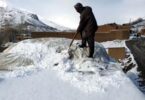Akhtar Amin
The Taliban who took control of Afghanistan ahead of the withdrawal of American forces, now have the serious challenge of governing a nation that relies heavily on international aid and is currently in a worsening economic crisis. In addition civil servants haven’t been paid in months and the local currency is losing value. Whereas most of Afghanistan’s foreign reserves are held abroad and currently frozen, further aggravates the situation and may lead to a hunger crisis in addition to the other challenges facing the country.
The U.N.’s World Food Program has brought in food and distributed it to tens of thousands of people in recent weeks, but with winter approaching and a drought ongoing, at least $200 million is needed urgently to be able to continue to feed the most vulnerable Afghans. Afghanistan is a country that comprises of numerous ethno linguistic groups: Pashtun, Tajik, Hazara, Uzbek, Aimaq, Turkmen, Baloch, Pashai, Nuristani, Gujjar, Arab, Brahui, Qizilbash, Kyrgyz, Sadat etc. The Taliban has traditionally drawn on ethnic Pashtuns against the Afghan government, but it has begun to successfully recruit disgruntled members of other ethnic groups as it expands its reach. This is evidently means that time around, the Taliban had a new strategy. They have enlisted minorities in the north and turn a Pashtun-based insurgency into a pan-Islamic fighting force against foreign infidels.
Unconfirmed data reveals that the non-Pashtuns make up around one-quarter of the Taliban leadership council and its various commissions. In January this year, at least three non-Pashtuns were inducted to the leadership council disenfranchised communities of ethnic Tajiks, Turkmen, and Uzbeks. Inclusive Government and good governance under the Taliban Emarat Islami in Afghanistan can function to decrease the political divisions between different ethnic groups. This could firstly be brought about by amending the constitution and changing the system of government to federal or semi-presidential system. Secondly, reforms could be brought to the current electoral system to strengthen political parties and ensure a just and inclusive set of representative rights for all segments.
There are a broad range of governing models available and almost every country has a unique approach in some respects. However, there is a fundamental disparity between the nature of a republic and that of an emirate. Afghanistan’s 2004 constitution established a republican form of government, defined as one in which sovereignty belongs “to the nation, manifested directly and through its elected representatives. The key attributes of “the republic” in the 2004 constitution are: sovereignty is manifested through the people, citizens; citizens choose their leaders through elections with universal suffrage; no one is above the law, which passes through an elected legislature. Therefore three independent branches of government check each other’s power; and all citizens have basic rights which cannot be infringed.
The parliamentary electoral system also does nothing to reduce ethnic tensions in Afghanistan. Afghanistan’s electoral law, adopted in 2004, relies on a Single Non-Transferrable Vote (SNTV) system for parliamentary elections. This system allows voters to cast votes to individual candidates not to political parties. One explanation for adopting this system was the poor performance of advocates of closed-list Proportional Representation (PR) system, which benefitted the opponents of a PR system who were worried about the emergence of strong political parties.
With all the challenges ahead the world must accept that the Taliban are back is power in Afghanistan that too on the 20th anniversary of 9/11 which indeed is immensely painful to the United States, NATO, and many Afghans. In 2001, the U.S. overthrew the Taliban regime to defeat al-Qaida, a goal it largely accomplished. But the U.S. also sought to vanquish the Taliban and leave behind a pluralistic, human-rights-respecting, and economically-sustainable Afghan state.
To go with the new development the world must not lose focus and humanitarian assistance to Kabul because the challenges are mounting in the wake of the Taliban’s rapid takeover. Thousands continued to defy warnings and beatings to seek evacuation via the capital’s airport. The UN Security Council, currently being presided over by India, has declared that it does “not support the restoration of the Islamic Emirate” in Afghanistan as it expressed deep concern over the high levels of violence in the war-torn country following the Taliban stepping up its military offensive. The 15-nation Security Council reaffirmed that there is no military solution to the conflict and “declared that they do not support the restoration of the Islamic Emirate.”
Ethnic minorities have also gained a larger number of provincial and district shadow governorships and zonal commands. The insurgent shadow governments and military structures in the north have increasingly adapted to be more accommodating to non-Pashtuns who are willing to fight under the flag of the Taliban’s Islamic Emirate, but not directly under Pashtuns. With victory now in hand, the Taliban say they have returned to power stronger than they were in the 1990s, not only armed with the captured U.S.-supplied military hardware of the Afghan army, but now with a nationwide network of loyalist fighters which will make them a force to beat by foreign powers in years to come.
The Writer is a Freelance Contributor and PhD Scholar at the Institute of Peace and Conflict Studies, University of Peshawar.






